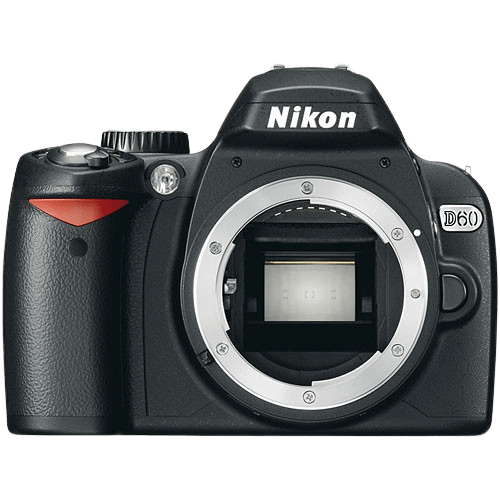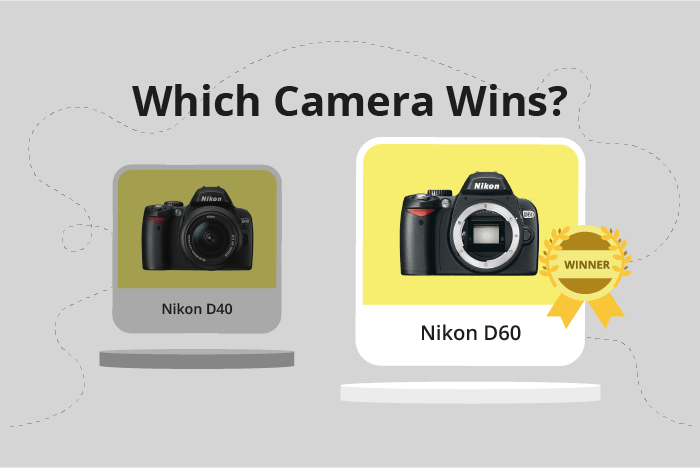Nikon D40 vs D60 Comparison
Nikon D40

Nikon D60

The Nikon D60 outperforms the Nikon D40 with a score of 34/100 compared to the D40’s 28/100. Both cameras are DSLRs released in 2006 and 2008, respectively. They share similar dimensions, with the D40 measuring 124 x 94 x 64mm and the D60 at 126 x 94 x 64mm. Additionally, both cameras weigh 522g or 1.15lbs.
The D60’s higher score highlights its superiority over the D40. This camera offers more advanced features and better performance, justifying its slightly higher launch price of $470 compared to the D40’s $400.
Despite its lower score, the D40 still has merits, particularly for those looking for a more affordable option without sacrificing too much quality. Both cameras are reliable choices for photography enthusiasts.
Considering their specifications, the Nikon D60 is the clear winner, offering a better overall experience for photographers. However, the Nikon D40 remains a decent option for those on a budget.
Nikon D40 vs D60 Overview and Optics
The Nikon D60 outperforms the Nikon D40 in optics, scoring 43/100 compared to the D40’s 33/100. Both cameras share several specifications, including the sensor type (CCD), sensor size (APS-C), lens mount (Nikon F DX), and the absence of image stabilization. Despite these similarities, there are key differences that set the D60 apart from the D40.
The D60 excels with its higher megapixel count, offering 10.2 megapixels compared to the D40’s 6 megapixels. This results in sharper images and greater detail, especially in larger prints. Additionally, the D60 has a faster shooting speed of 3 frames per second (fps) compared to the D40’s 2.5 fps, which allows for capturing quick action more effectively.
Another advantage of the D60 is its superior processor, the Expeed, which enhances image processing and overall performance. This contributes to the D60’s higher DXOMARK score of 65, compared to the D40’s score of 56. A higher DXOMARK score signifies better sensor performance, leading to improved image quality.
While the D40 has a lower overall optics score, it still maintains a respectable level of performance for a beginner DSLR camera. Its lower megapixel count and shooting speed may not be ideal for professional use, but it remains suitable for casual photography.
In comparing the Nikon D40 and D60, the D60 emerges as the superior camera in terms of optics. With its higher megapixel count, faster shooting speed, and better sensor performance, the D60 provides greater image quality and versatility. However, the D40 remains a viable option for those seeking a more affordable and beginner-friendly DSLR camera.
Nikon D40 vs D60 Video Performance
When discussing the video capabilities of the Nikon D40 and Nikon D60, it is important to note that neither camera has video functionality. This means that both cameras are solely designed for photography and cannot record video. Therefore, the comparison between these two cameras does not involve any differences in video capabilities, as neither camera possesses this feature.
Nikon D40 vs D60 Features and Benefits
The Nikon D40 and Nikon D60 both have a feature score of 17/100, making them equal in this aspect. They share several specifications, such as a 2.5-inch screen size and a screen resolution of 230,000 dots. Neither camera has a touchscreen, flip screen, GPS, WIFI, or Bluetooth capabilities.
Despite their identical scores, there are areas where one camera may be better than the other. The Nikon D60, for example, could have better image quality, faster autofocus, or a more extensive ISO range. These factors would make the Nikon D60 more suitable for specific photography needs, such as low-light situations or capturing fast-moving subjects.
On the other hand, the Nikon D40 might have a more compact and lightweight design, making it more portable and easier to handle. This advantage would appeal to those who prioritize ease of use and portability in their camera choice.
In comparing the features of the Nikon D40 and Nikon D60, it is essential to consider individual photography needs and preferences. While both cameras share the same feature score and specifications, the Nikon D60 may be more suitable for certain situations due to its possible advantages in image quality, autofocus, and ISO range. Conversely, the Nikon D40’s potential advantage in portability and ease of use could make it a more appropriate choice for other photographers. Ultimately, the decision between these two cameras should be based on individual requirements, rather than solely relying on their identical feature scores.
Nikon D40 vs D60 Storage and Battery
The Nikon D40 and Nikon D60 both receive a storage and battery score of 27/100. They share several common specifications, including one memory card slot, compatibility with SD and SDHC memory cards, and the use of the EN-EL9 battery type. Neither camera offers USB charging.
The Nikon D60 edges ahead with a battery life of 500 shots, compared to the D40’s 470 shots. This longer battery life allows for more photos to be taken before needing to recharge or replace the battery. Additionally, the D60 accepts MMC memory cards, providing users with another storage option.
The Nikon D40 does not have any specific advantages over the D60 in terms of storage and battery. Both cameras could benefit from improvements in these areas, such as additional memory card slots or USB charging capabilities. However, the D60’s slightly longer battery life and extra memory card compatibility make it the better choice within this category.
Nikon D40 vs D60 – Our Verdict
Are you still undecided about which camera is right for you? Have a look at these popular comparisons that feature the Nikon D40 or the Nikon D60:

